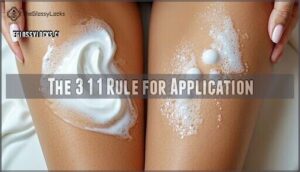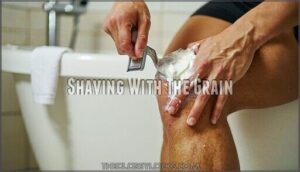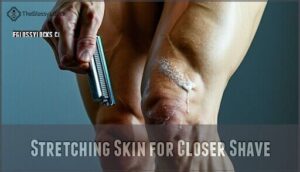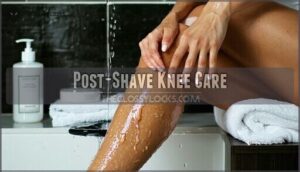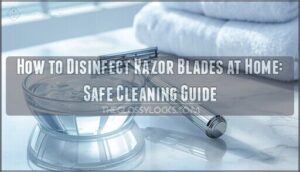This site is supported by our readers. We may earn a commission, at no cost to you, if you purchase through links.
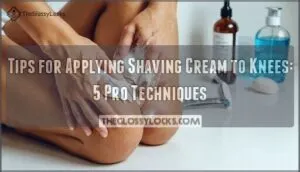
Work the cream in circular motions around your kneecap, paying extra attention to the sides where your leg curves inward.
Don’t rush this step; knees have multiple angles that need even coverage to prevent razor burn and missed spots.
Use enough cream to create a protective barrier, but not so much that it slides off when you move, aiming for smooth, consistent coverage that follows your knee’s natural contours.
Getting this foundation right sets you up for techniques that’ll transform your knee-shaving game completely, ensuring a better shaving experience with proper coverage.
Table Of Contents
- Key Takeaways
- Preparing Knees for Shaving
- Choosing Right Shaving Cream
- Applying Shaving Cream
- Shaving Techniques for Knees
- Post-Shave Knee Care
- Frequently Asked Questions (FAQs)
- What’s the best way to shave your knees?
- How to apply shaving cream to legs?
- Why are you not supposed to shave above your knees?
- Do you put shaving cream on wet or dry legs?
- How do you shave your knees?
- How to apply shaving cream on legs?
- What is the 3 1 1 rule for shaving cream?
- Why is it so hard to shave my knees?
- How often should I exfoliate my knees for smooth shaving?
- What are the benefits of using a shaving brush on knees?
- Conclusion
Key Takeaways
- You’ll want to bend your knee slightly and work shaving cream in circular motions to reach all angles and skin folds where hair hides.
- Don’t rush the application process—focus on creating thick, even coverage that follows your knee’s natural contours without sliding off when you move.
- Prepare properly by soaking knees in warm water for 3-5 minutes and gently exfoliating to remove dead skin cells before applying moisturizing ingredients.
- Choose the right cream for your skin type, looking for ingredients like aloe vera and glycerin if you have sensitive or dry skin.
Preparing Knees for Shaving
Proper preparation sets the foundation for a smooth, irritation-free knee shave that protects your skin while delivering professional results.
You’ll want to hydrate the skin for 3-5 minutes in warm water, gently exfoliate to remove dead skin cells, and map your hair growth direction before applying any shaving cream to ensure a smooth shave.
Soaking Knees in Warm Water
Before shaving your knees, give them a five-minute warm soak to reveal smoother results.
Proper water temperature between 98-104°F guarantees superior skin hydration while softening hair follicles.
This knee preparation step transforms stubborn hairs into manageable targets for your razor.
The warm soak opens pores and creates ideal conditions for shaving cream application, making your knee shaving guide complete.
Exfoliating Knees for Smooth Skin
Gentle knee exfoliation creates the perfect canvas for smooth shaving.
Perfect prep work transforms your knees into a flawless shaving canvas.
You’ll want to remove dead skin cells that can clog your razor and cause irritation. Use a loofah or gentle scrub in circular motions, focusing on bumpy areas.
This dead cell removal prevents razor drag and ingrown hairs. Think of it as prep work—like sanding before painting.
Your knee skin care routine should include this essential step for achieving that silky-smooth finish you’re after.
Mapping Hair Growth on Knees
Before you shave those knee hairs, take a moment to study their growth patterns.
Hair around knee contours grows in multiple directions – some flows upward, some sideways, and patches may swirl unpredictably.
Run your hand gently across the knee area to feel which way the hair lies naturally.
This shave mapping step prevents razor burn and guarantees your curved shaving technique follows the proper growth direction for safer knee hair removal, using a curved shaving technique.
Choosing Right Shaving Cream
You’ll need the right shaving cream to protect your knees from irritation and cuts during this tricky shave.
The cream you choose should match your skin type and hair texture to create the perfect glide over those bumpy, curved surfaces, using the right cream.
Ingredients for Sensitive Skin
Looking for the right ingredients can make or break your knee shaving experience, especially if you’re dealing with sensitive skin.
The wrong formula might leave you looking like you wrestled with a cheese grater.
Here are four skin-saving ingredients to seek out:
- Aloe Vera – This green miracle worker hydrates while calming irritation, perfect for sensitive skin that throws tantrums
- Glycerin – Acts like a moisture magnet, drawing hydration from the air to keep your knees supple during shaving
- Natural Oils (like macadamia or sunflower) – These gentle moisturizers create a protective barrier without clogging pores
- Chamomile Extract – Nature’s chill pill for angry skin, reducing redness and inflammation
Choose sensitive formulas with these skin soothers for ideal skin hydration and moisturizing benefits on your knees.
For a comfortable shave, consider using a sensitive skin product that’s designed to prevent irritation and razor burn.
Creams for Coarse Hair
Thick, coarse knee hair demands heavy-duty shaving creams with rich lathering formulas.
Look for products containing shea butter, lanolin, or vitamin E—these hair softeners tackle stubborn growth while protecting sensitive skin.
Barbasol Extra Moisturizing and Proraso formulations create dense cushioning that prevents razor tugging on bumpy knees, reducing irritation and improving your overall shaving experience.
For a smooth shave, consider using a paraben free product that’s gentle on the skin.
Shaving Cream for Dry Skin
When dealing with dry skin on your knees, you’ll need a shaving cream for dry skin that packs extra moisturizing power.
Look for moisturizing cream formulas containing glycerin, aloe vera, or shea butter – these ingredients create a protective barrier while you shave.
Sensitive skin types benefit most from fragrance-free options that won’t irritate already compromised skin barriers around your knees.
Using a moisturizing shave cream can help lock in moisture and reduce irritation.
Applying Shaving Cream
Proper shaving cream application creates the foundation for a comfortable, nick-free shave on your knees.
You’ll need to master coverage techniques that work with the knee’s unique contours and bony surfaces to avoid irritation and missed spots, ensuring a nick-free shave.
The 3 1 1 Rule for Application
Apply a pea to nickel-sized amount of shaving cream for knees using the 3 1 1 rule: proper cream application guarantees adequate lather thickness without waste.
This measured approach optimizes razor prep and maintains skin tension during shave mapping.
The right amount creates protective coverage while preventing over-application that compromises blade efficiency and increases irritation risk.
Lathering on Curved Areas
Navigating knee contours requires strategic lathering techniques. The curved surface demands careful attention to confirm complete coverage without missing spots.
Key lathering strategies:
- Work in small sections – Don’t rush the knee area’s complex angles
- Use circular motions – Follow the natural knee contours for even distribution
- Build proper lather thickness – Ensures ideal razor glide over bumpy surfaces
Focus on shaving angles when applying cream to knee areas. The curved surface creates natural valleys where cream can pool or miss entirely. Shaving knee safely means taking time with each application, especially around the kneecap’s prominence.
Tips for Even Coverage
Effective coverage tips guarantee your shaving cream tips work efficiently on the knee area. Use circular motions to distribute cream evenly around knee contours. Check for missed spots by examining your skin mapping before starting shave strokes.
Proper razor angle depends on complete coverage. Achieving a rich lather provides skin protection benefits that help prevent razor burn and irritation.
| Coverage Area | Technique |
|---|---|
| Kneecap | Circular application |
| Side curves | Vertical strokes |
| Back of knee | Gentle patting |
| Lower knee | Upward motions |
| Upper knee | Downward coverage |
Shaving Techniques for Knees
Now that you’ve applied your shaving cream, the actual shaving technique becomes essential for smooth, irritation-free knees.
Your approach to razor direction and skin positioning will determine whether you achieve professional results or deal with nicks and razor burn.
Shaving With The Grain
Once you’ve prepared your knees with shaving cream, shaving with the grain becomes your next move.
This technique follows your hair patterns naturally, reducing irritation and preventing razor burn.
Here’s how to master grain direction shaving:
- Map hair patterns – Run your hand across knees to feel growth direction
- Maintain proper razor angle – Keep blade at 30-degree angle to skin
- Use short shave strokes – Work in 1-2 inch sections for control
- Apply gentle skin tension – Stretch skin taut without overdoing it
- Rinse blade frequently – Clear hair buildup between strokes
This knee shaving technique protects sensitive skin while delivering smooth results.
Shaving Against The Grain
After your first pass, going against the grain can deliver that ultra-smooth finish you’re after. However, this technique comes with increased cut risk and irritation potential. Start slowly and listen to your skin.
The key lies in maintaining ideal razor angle while managing skin tension. Your knee’s curved surface requires extra attention to grain direction. Reapply shaving cream application tips between passes, especially when shaving sensitive skin around the knee area.
This shaving technique prevents irritation while maximizing results through careful irritation prevention methods. To achieve the best results, understanding shaving techniques is vital for a smooth shave.
| Technique | Benefit | Risk Level |
|---|---|---|
| Light pressure | Closer shave | Medium |
| Proper angle | Smooth results | Medium |
| Fresh blade | Clean cut | Low |
| Gradual strokes | Even coverage | High |
Stretching Skin for Closer Shave
Gently pull your knee skin taut with your free hand to create a smooth surface for shaving.
This stretching technique eliminates wrinkles and bumps that can catch the razor, allowing for better skin tension and smoother shave strokes.
Proper knee bending helps access tricky angles while maintaining the right razor angle for effective knee shaving cream application on sensitive skin areas.
Post-Shave Knee Care
Once you’ve mastered the shaving technique, proper post-shave care guarantees your knees stay smooth and irritation-free.
The right combination of cold water, moisturizer, and soothing balm can prevent razor burn and keep your skin healthy for days, which is crucial for maintaining healthy skin.
Moisturizing After Shaving
Right after shaving your knees, moisturize while skin’s still damp.
Your freshly shaved skin loses natural oils, making it vulnerable to dryness and irritation.
Apply a fragrance-free moisturizer in circular motions for even coverage.
This locks in hydration, reduces razor burn, and prevents those annoying bumps.
Your knees will thank you with smoother, healthier-looking skin.
Using the right skin care products is essential for maintaining healthy skin after shaving, and finding the best products is crucial for even coverage and to prevent dryness.
Using Post-Shave Balm
After moisturizing, apply post-shave balm for enhanced Razor Relief and Skin Soothing.
Quality Balm Ingredients like aloe vera and chamomile provide superior Balm Benefits compared to basic postshave care.
Choose alcohol-free formulas for knee care tips – they won’t sting freshly shaved skin.
These Aftercare Tips help your shaving knee area recover faster, making your shaving cream routine more effective overall.
Using a post shave balm can substantially improve the skin’s healing process after shaving, which is an important part of Skin Soothing.
Cold Water Rinse Benefits
After applying post-shave balm, finish with cold therapy for ideal knee care.
Cold water rinse provides immediate relief and promotes healing.
- Pore Closure – Cold water tightens pores, preventing bacteria from entering freshly shaved follicles
- Skin Tightening – Cool temperatures firm the skin around your knee area for smoother results
- Reduced Irritation – Cold therapy calms inflamed tissue and minimizes razor burn
- Improved Healing – Lower temperatures boost circulation, accelerating skin repair after shaving
- Enhanced Protection – Closed pores create a natural barrier against environmental irritants
Frequently Asked Questions (FAQs)
What’s the best way to shave your knees?
Bend your knee to create a flat surface, then apply thick shaving cream in circular motions.
Use short, gentle strokes with the grain, rinsing your razor frequently to prevent clogging and irritation.
shaving cream
How to apply shaving cream to legs?
Apply shaving cream to wet legs in circular motions, creating a thick layer that covers all areas.
Focus on knees by bending your leg to access all angles and contours properly.
Why are you not supposed to shave above your knees?
Actually, shaving above your knees isn’t forbidden—it’s perfectly safe and normal.
The misconception stems from old-fashioned beauty standards suggesting women only needed smooth lower legs.
Today, you’re free to shave wherever you want for comfort and confidence.
Do you put shaving cream on wet or dry legs?
You’ll want to apply shaving cream to wet legs. Moisture softens hair and opens pores, making shaving easier and reducing irritation. Dry application won’t provide proper glide or protection.
How do you shave your knees?
Bend your knee slightly to stretch the skin taut, then use short, gentle strokes with the grain.
Rinse your razor frequently and reapply shaving cream if needed for multiple passes around the kneecap’s curves.
How to apply shaving cream on legs?
Ironically, most people slather shaving cream everywhere except where they need it most. Start with wet legs, then apply cream in circular motions, covering knees thoroughly with thick layers.
What is the 3 1 1 rule for shaving cream?
The 3-1-1 rule limits you to 4-ounce containers in one quart-sized bag for carry-on travel.
Your shaving cream must fit this TSA liquids restriction or go in checked luggage instead.
Why is it so hard to shave my knees?
Knees are tricky because they’re all curves and angles – the bony surface makes razor blades skip, while loose skin around the joint moves unpredictably as you shave.
How often should I exfoliate my knees for smooth shaving?
Like preparing a canvas for fine artwork, you’ll want to exfoliate your knees 2-3 times weekly before shaving.
This removes dead skin cells that can clog your razor and cause irritation, ensuring smoother results every time.
What are the benefits of using a shaving brush on knees?
A shaving brush lifts hair from your skin’s surface and creates richer lather than hands alone.
You’ll get better cream distribution around knee contours and achieve a closer, smoother shave with less irritation.
Conclusion
Practice makes perfect in the case of mastering these tips for applying shaving cream to knees.
You’ve learned the essential techniques for prep work, product selection, and proper application methods.
Remember to bend your knee slightly, work cream into all curves, and don’t rush the process.
These tips for applying shaving cream to knees will help you achieve smoother results with fewer nicks and irritation.
Your knees deserve the same attention as any other area you shave, which is why following these guidelines is crucial for a better shaving experience.
- https://augustinusbader.com/sg/en/evidence/how-to-achieve-the-perfectly-smooth-shaven-legs
- https://keepwellkept.com/blogs/journal/shaving-ankles-knees-shins
- https://www.wilkinsonsword.com/blogs/womens/how-to-shave-your-legs-how-often-in-what-direction
- https://www.healthywomen.org/content/article/top-mistakes-youre-making-when-shaving-your-legs
- https://health.clevelandclinic.org/want-a-smooth-safe-shave-every-time-try-these-10-tips


